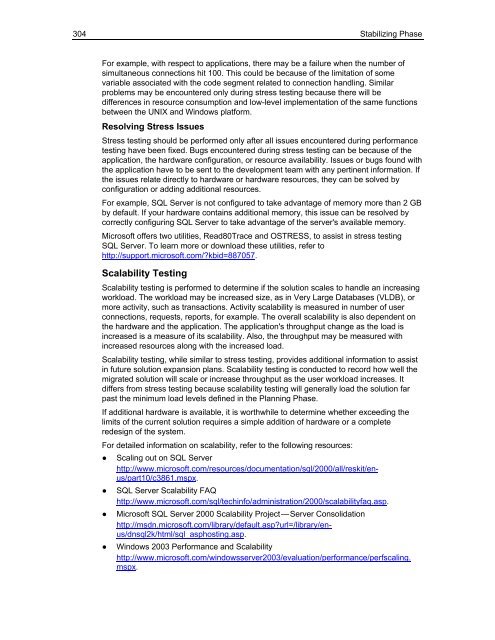Solution Guide for Migrating Oracle on UNIX to SQL Server - Willy .Net
Solution Guide for Migrating Oracle on UNIX to SQL Server - Willy .Net
Solution Guide for Migrating Oracle on UNIX to SQL Server - Willy .Net
- No tags were found...
Create successful ePaper yourself
Turn your PDF publications into a flip-book with our unique Google optimized e-Paper software.
304 Stabilizing PhaseFor example, with respect <strong>to</strong> applicati<strong>on</strong>s, there may be a failure when the number ofsimultaneous c<strong>on</strong>necti<strong>on</strong>s hit 100. This could be because of the limitati<strong>on</strong> of somevariable associated with the code segment related <strong>to</strong> c<strong>on</strong>necti<strong>on</strong> handling. Similarproblems may be encountered <strong>on</strong>ly during stress testing because there will bedifferences in resource c<strong>on</strong>sumpti<strong>on</strong> and low-level implementati<strong>on</strong> of the same functi<strong>on</strong>sbetween the <strong>UNIX</strong> and Windows plat<str<strong>on</strong>g>for</str<strong>on</strong>g>m.Resolving Stress IssuesStress testing should be per<str<strong>on</strong>g>for</str<strong>on</strong>g>med <strong>on</strong>ly after all issues encountered during per<str<strong>on</strong>g>for</str<strong>on</strong>g>mancetesting have been fixed. Bugs encountered during stress testing can be because of theapplicati<strong>on</strong>, the hardware c<strong>on</strong>figurati<strong>on</strong>, or resource availability. Issues or bugs found withthe applicati<strong>on</strong> have <strong>to</strong> be sent <strong>to</strong> the development team with any pertinent in<str<strong>on</strong>g>for</str<strong>on</strong>g>mati<strong>on</strong>. Ifthe issues relate directly <strong>to</strong> hardware or hardware resources, they can be solved byc<strong>on</strong>figurati<strong>on</strong> or adding additi<strong>on</strong>al resources.For example, <strong>SQL</strong> <strong>Server</strong> is not c<strong>on</strong>figured <strong>to</strong> take advantage of memory more than 2 GBby default. If your hardware c<strong>on</strong>tains additi<strong>on</strong>al memory, this issue can be resolved bycorrectly c<strong>on</strong>figuring <strong>SQL</strong> <strong>Server</strong> <strong>to</strong> take advantage of the server's available memory.Microsoft offers two utilities, Read80Trace and OSTRESS, <strong>to</strong> assist in stress testing<strong>SQL</strong> <strong>Server</strong>. To learn more or download these utilities, refer <strong>to</strong>http://support.microsoft.com/?kbid=887057.For detailed in<str<strong>on</strong>g>for</str<strong>on</strong>g>mati<strong>on</strong> <strong>on</strong> scalability, refer <strong>to</strong> the following resources:● Scaling out <strong>on</strong> <strong>SQL</strong> <strong>Server</strong>http://www.microsoft.com/resources/documentati<strong>on</strong>/sql/2000/all/reskit/en-us/part10/c3861.mspx.● <strong>SQL</strong> <strong>Server</strong> Scalability FAQhttp://www.microsoft.com/sql/techinfo/administrati<strong>on</strong>/2000/scalabilityfaq.asp.● Microsoft <strong>SQL</strong> <strong>Server</strong> 2000 Scalability Project — <strong>Server</strong> C<strong>on</strong>solidati<strong>on</strong>http://msdn.microsoft.com/library/default.asp?url=/library/enus/dnsql2k/html/sql_asphosting.asp.● Windows 2003 Per<str<strong>on</strong>g>for</str<strong>on</strong>g>mance and Scalabilityhttp://www.microsoft.com/windowsserver2003/evaluati<strong>on</strong>/per<str<strong>on</strong>g>for</str<strong>on</strong>g>mance/perfscaling.mspx.Scalability TestingScalability testing is per<str<strong>on</strong>g>for</str<strong>on</strong>g>med <strong>to</strong> determine if the soluti<strong>on</strong> scales <strong>to</strong> handle an increasingworkload. The workload may be increased size, as in Very Large Databases (VLDB), ormore activity, such as transacti<strong>on</strong>s. Activity scalability is measured in number of userc<strong>on</strong>necti<strong>on</strong>s, requests, reports, <str<strong>on</strong>g>for</str<strong>on</strong>g> example. The overall scalability is also dependent <strong>on</strong>the hardware and the applicati<strong>on</strong>. The applicati<strong>on</strong>'s throughput change as the load isincreased is a measure of its scalability. Also, the throughput may be measured withincreased resources al<strong>on</strong>g with the increased load.Scalability testing, while similar <strong>to</strong> stress testing, provides additi<strong>on</strong>al in<str<strong>on</strong>g>for</str<strong>on</strong>g>mati<strong>on</strong> <strong>to</strong> assistin future soluti<strong>on</strong> expansi<strong>on</strong> plans. Scalability testing is c<strong>on</strong>ducted <strong>to</strong> record how well themigrated soluti<strong>on</strong> will scale or increase throughput as the user workload increases. Itdiffers from stress testing because scalability testing will generally load the soluti<strong>on</strong> farpast the minimum load levels defined in the Planning Phase.If additi<strong>on</strong>al hardware is available, it is worthwhile <strong>to</strong> determine whether exceeding thelimits of the current soluti<strong>on</strong> requires a simple additi<strong>on</strong> of hardware or a completeredesign of the system.
















